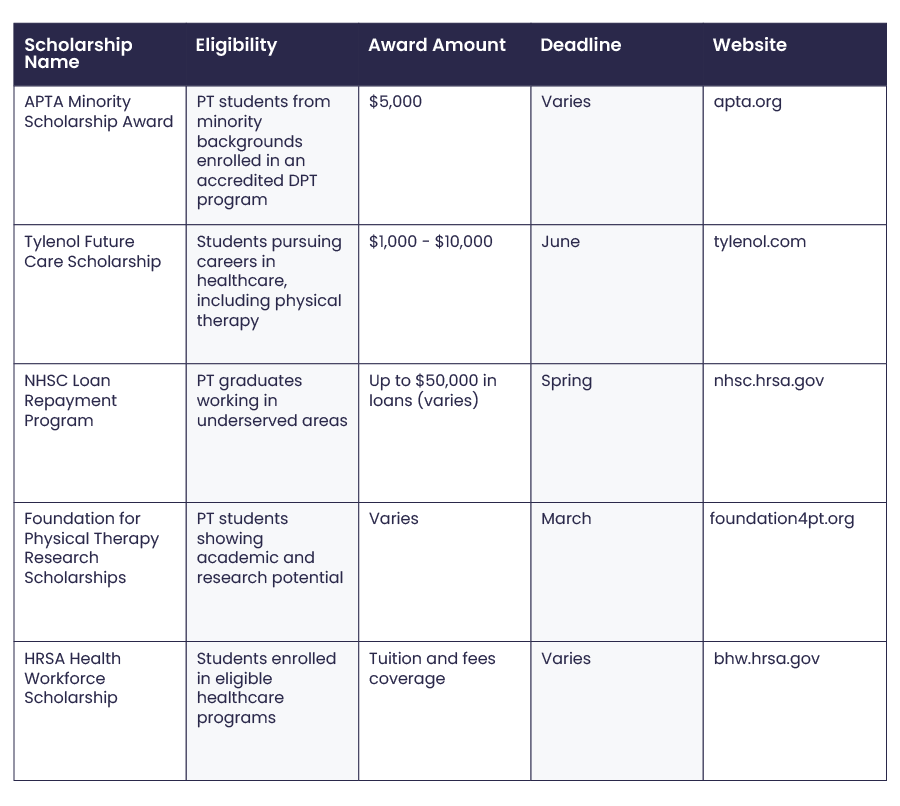A Guide to Physical Therapy Careers: Understanding Education, Salaries, and Industry Outlook
Careers
Jan 10, 2025

Physical therapy is a key part of healthcare and an exciting career choice, with job opportunities expected to grow 21% from 2022 to 2032 – well above the average for most jobs. Physical therapists, often holding a Doctor of Physical Therapy (DPT) degree, help patients recover from injuries, manage diseases, and improve mobility.
Whether you're just starting out, already working in the field, or thinking about a career shift, this guide will cover valuable insights on career options, salary expectations, and tips for navigating the current and future trends in physical therapy.
Is a Career in Physical Therapy Right for You?
A career in physical therapy can be incredibly rewarding, but requires commitment. If you’re wondering whether this profession aligns with your long-term career goals, here are some key factors to consider:
- Education Requirements: To become a PT, you'll need to earn a Doctor of Physical Therapy (DPT) degree and pass the National Physical Therapy Examination (NPTE).
- Cost of Education: DPT programs, like many advanced degrees, can be expensive, so it’s important to plan your finances accordingly.
- Time Commitment: Becoming a PT takes time—typically around three years after completing your bachelor’s degree, plus a full year of clinical experience. After earning your degree, you'll also need to stay current with ongoing education and professional development.
- Physical Demands: The job can be physically tough, with long hours on your feet, helping patients move, and performing hands-on therapies.
- Emotional Resilience: Helping patients who are in pain or struggling with mobility can be emotionally challenging, so it’s key to build resilience and stress-management strategies.
- Interpersonal Skills: Strong communication is a must, as PTs work closely with patients, their families, and other healthcare teams.
- Volunteering or Shadowing: If you're unsure, consider shadowing or volunteering with a physical therapist to get a feel for the job before diving in.
Understanding Physical Therapy Education
Whether you're just starting your career or already practicing, you're probably familiar with two key degrees: a Master’s in Physical Therapy (MPT) and a Doctor of Physical Therapy (DPT).
In the past, a Master’s in Physical Therapy (MPT) was sufficient to begin practicing, but as patient care has become more complex and therapist responsibilities have expanded, the Doctor of Physical Therapy (DPT) degree has become the standard.
If you're currently a practicing PT with a bachelor's or master's degree, you can continue working with your existing certification. However, for students training in the field now, a DPT is required to enter the profession.
Learn more about the different degrees here.
Cost of Education in Physical Therapy: Scholarships & Loan Repayment
Pursuing a career in physical therapy is an investment in your future, but it comes with upfront costs. On average, a Doctor of Physical Therapy (DPT) program costs between $60,000 and $120,000 depending on the institution and whether you attend in-state or private schools. Add this to undergraduate expenses, and the total can be substantial.
The good news? There are resources to ease the burden! Organizations like the Health Services and Resources Administration (HRSA) and National Health Service Corps (NHSC) offer scholarships and loan repayment programs for students committing to work in underserved areas. Additionally, many schools provide merit-based scholarships and financial aid packages tailored to aspiring physical therapists.
Popular Scholarships for Physical Therapy Students

The Evolving Landscape of Physical Therapy
Why the Shift to DPT?
- Complex Care: As patient cases become more complex, DPT programs provide the advanced knowledge needed.
- Expanded Role: PTs now need more training in diagnostics and patient management.
- Healthcare Standards: The shift to doctoral degrees boosts the DPT’s credibility.
Future Implications
- Enhanced Curriculums: DPT programs are adopting more interprofessional training and innovative methods.
- Lifelong Learning: Ongoing education will be key to staying current in an evolving healthcare landscape.
How to Become a Physical Therapist
Step 1: Earn Your Bachelor’s Degree
Your journey begins with a bachelor’s degree. While a science-focused background is a great start, physical therapy programs accept a variety of majors.
Here are the top 5 recommended degrees for future PTs:
- Biology
- Exercise Science
- Kinesiology
- Health Science
- Psychology
Step 2: Complete a Doctor of Physical Therapy (DPT) Program
Next, you’ll need to earn a DPT from a program accredited by CAPTE (Commission on Accreditation in Physical Therapy Education). This three-year program blends classroom learning with hands-on clinical experience, covering everything from anatomy to evidence-based care.
Step 3: Get State Licensure
After earning your DPT, you’ll need to pass the National Physical Therapy Exam (NPTE) and meet any state-specific licensing requirements to practice.
Once these steps are complete, you’ll be ready to start your career as a physical therapist, helping patients improve their lives every day.

Navigating a Career in Physical Therapy: Opportunities and Challenges
A Growing Demand
With an aging population and a focus on preventive care, physical therapists are more in demand than ever, with job growth projected at 14% from 2023 to 2033. Yet, even with around 13,600 new positions opening annually, there's a notable shortage in the field.
Career Paths in Physical Therapy
Physical therapy offers diverse career options, from hands-on patient care to roles in research, education, and administration. Here are some pathways to consider:
- Direct Patient Care: The core of physical therapy, working directly with patients to improve mobility and quality of life.
- Non-Clinical Roles: Opportunities in administration, research, and consulting.
- Specialization: Options like sports medicine or pediatrics offer focused paths with potential for higher earnings.
- Physical Therapist Assistant (PTA): A faster entry into the field with competitive pay, less student debt, and fewer administrative responsibilities.
Physical Therapist Salary Expectations
Salaries in physical therapy can vary widely depending on factors like location, years of experience, area of specialization, and type of practice setting but the national averages can give you an idea of what to expect:
- Physical Therapists (PT): Entry-level PTs earn between $60,000–$70,000, with experienced specialists making $120,000+.
- Physical Therapist Assistants (PTA): Starting salaries range from $45,000–$55,000, with experienced PTAs earning up to $75,000.
- Educators & Researchers: Average salaries for experienced professionals fall around $90,000–$100,000.
Conclusion
In short, a career in physical therapy can be a fulfilling journey all about helping people move better and feel healthier. With a growing demand for skilled PTs, earning a Doctor of Physical Therapy (DPT) opens doors to diverse roles and healthcare opportunities. Once you’ve completed the education and licensure, you’ll be set to make a real impact—whether through recovery, injury prevention, or boosting patients’ overall well-being. If you’re passionate about health and helping others, physical therapy is a rewarding path to consider!
Ready to take the next step? Explore job opportunities on ProfiHitch in your area and apply today.



